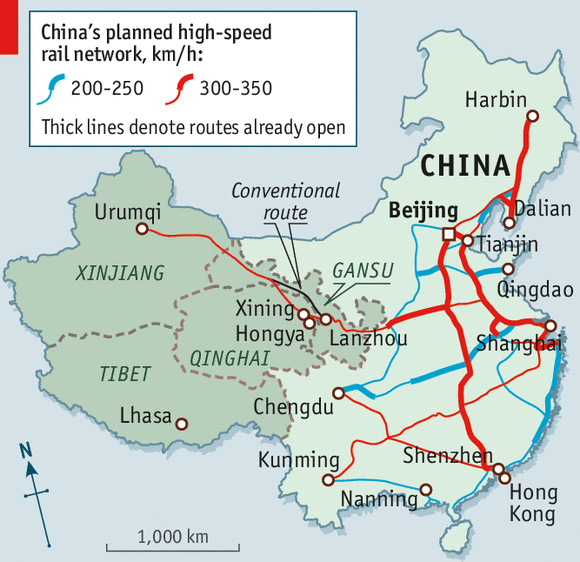
China already possesses the largest and longest high-speed rail network in the world. Its total length is 6,200 miles, making it longer than that of all of Europe’s put together. Demand seems to be no issue, these high-speed trains transporting almost 2 million people a day (a third of total number of rail passengers). This system (gaoti in Chinese) has focused on laying tracks in the densely populated eastern side of China, a line from Beijing to Shenzhen linking 28 cities in multiple provinces. Since 2009, tracks have been being laid to connect as far as Xinjiang (an area that we recall is attracting industry).
Interestingly, plans include building the tracks through the Tibetan plateau, which will require it to run in less populated areas, as well as necessitate large scale construction of the train line at high altitudes due to the terrain (which will mean these bullet trains will travel higher than any other in the world). Despite these avoidable and less than ideal factors, it is reported that the government has chosen this route as a political move to promote harmony with the ethnic groups in the area, as well as to reach out to Tibetans (although the region the train will run through is not near Tibet, it is considered historically Tibetan territory).

These rail track extensions are particularly welcomed by the Qinghai province as an excuse for heavy spending for “business parks and apartment blocks around lavish new railway stations). The new tracks will also provide easier transport for tourists coming to see the yellow fields of rape blossoms located near Menyuan, which will have a new station with this plan. Xinjiang hopes to benefit most from the new line, as passengers will be able to travel through the bullet trains, rather than the old rail line which can be dedicated to freight to transport coal at greater quantities.
In just five years, China has introduced this high-speed rail system, and have constructed nearly 6,200 miles of tracks (and this number is expected to rise to 9,320 miles in just the next two years). While the railway has been successful to date, some of the downfalls include expensive tickets that are difficult to obtain, as well as a crash in Wenzhou back in 2011 from poor management. China is clearly making a push to be one of the pioneers in the high-speed bullet train industry, which has a lot of positive implications for the country. Decreased commuting time, increased commuting capacity, increased public transportation, and the connection of different parts of the country are all strong economic drivers.
Source: http://www.irishtimes.com/business/sectors/transport-and-tourism/asia-briefing-china-on-journey-to-becoming-major-player-in-rail-technology-1.1599065
High-speed railways could both positively and negatively impact migration. Reducing the cost associated with migrating across the country will lead to increased migration from rural areas to more densely populated urban cities. Farmers who live near a city but are not within walking distance might be more inclined to use this public transportation to work in the city by day and go home to the village in the evening. Finally, it would be interesting to see how wages become effected by increased transportation. A factor might loose more workers if it lowered its wage as the cost of moving decreases.
Hopefully China is not building this network too quickly or without proper quality control measures. I know there was some speculation regarding the high speed rail crash of 2011 in Wenzhou that the whole project was at least slightly substandard. I do think that is the risk of building so much so quickly, no one is double checking to ensure safety. The early US railroads were quite similar, in that they were low quality and caused lots of derailments and problems, especially in the South. I think their system is impressive and the countries high density will make it viable over the long run.
http://www.newyorker.com/reporting/2012/10/22/121022fa_fact_osnos
I agree with Mark, but fortunately, China has the ability to look at large scale past endeavors, which the US did not during the time. The vast geographic size of China coupled with the overwhelming population places China in a unique situation to really leverage the potential for high-speed travel infrastructure. Reilly highlights a few of the principle externalities derived from the implementation of a large-scale travel infrastructure and it will be interesting to see how China manages the quality of the infrastructure. The previous derailment issues in south China ostensibly should be not only correctable but avoidable in the future. If this infrastructure is intelligently constructed, China could realize significant improvements in both commerce and average income per capita growth.
This is probably something we take for granted simply due to the vast amount of infrastructure that cropped up so quickly during the American Industrial Revolution. Even though we still have big projects and a lot of revamping done every year, they are mostly just additions to the infrastructure we already have. There are not many vast terrains in the U.S. that we have yet to traverse with infrastructure of some kind. This may be a very ambitious project for the Chinese, but it could lay the groundwork for innovation and communication they never knew was possible, further bolstering their already impressive economic growth.